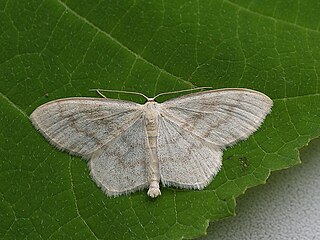
The geometer moths are moths belonging to the family Geometridae of the insect order Lepidoptera, the moths and butterflies. Their scientific name derives from the Ancient Greek geo γεω, and metron μέτρον "measure" in reference to the way their larvae, or inchworms, appear to measure the earth as they move along in a looping fashion. A very large family, it has around 23,000 species of moths described, and over 1400 species from six subfamilies indigenous to North America alone. A well-known member is the peppered moth, Biston betularia, which has been subject of numerous studies in population genetics. Several other geometer moths are notorious pests.

The cream wave is a moth of the family Geometridae. The species was first described by Adrian Hardy Haworth in 1809. It is found in forest and woodland regions, feeding on grasses and small plants such as dandelion.

Scopula decorata, the middle lace border, is a moth of the family Geometridae. It is found throughout Europe.

Scopula immorata, the Lewes wave, is a moth of the family Geometridae. It is found throughout Europe and the Near East.

Scopula is a genus of moths in the family Geometridae described by Franz von Paula Schrank in 1802.

Scopula incanata is a moth of the family Geometridae. It is found from north-eastern Europe and the Caucasus to southern Siberia and northern Mongolia.

Scopula minorata is a moth of the family Geometridae. It was described by Jean Baptiste Boisduval in 1833. It is found in Africa south of the Sahara, the Arabian Peninsula and on the islands of the Indian Ocean. Furthermore, it is found in southern Europe. It can be distinguished from Scopula lactaria only by examination of its genitalia.

Scopula emutaria, the rosy wave, is a species of moth in the family Geometridae. It is found in western and south-western Europe and Romania. Also in North Africa.
Scopula adeptaria is a moth of the family Geometridae. It was described by Francis Walker in 1861. It is found in Sri Lanka, India, Taiwan, Hainan, southern Myanmar, Peninsular Malaysia, Borneo, the Philippines, Sumba and northern Australia.
Scopula subpunctaria is a moth of the family Geometridae. It is found from northern and north-eastern China to the southern Palearctic realm.
Scopula prouti is a moth of the family Geometridae. It is found from north-eastern China to Korea, Japan and south-eastern Russia.
Scopula indicataria is a moth of the family Geometridae. It is found in China, Korea, Japan and Russia.

Scopula beckeraria is a moth of the family Geometridae. It was described by Julius Lederer in 1853. It is found in Italy, Croatia, North Macedonia, Greece, Bulgaria, Romania, Ukraine, Russia, Turkey, Armenia, Israel, Lebanon, Iran, Turkmenistan and Kazakhstan.

Scopula caesaria is a moth of the family Geometridae. It has a wide range, including the Comoros, Mayotte, La Réunion, Madagascar and in Mauritius, Nigeria, South Africa, Tanzania, Gambia, Oman, the United Arab Emirates, New Guinea, Taiwan, Japan and Australia (Queensland).
Scopula confinaria is a moth of the family Geometridae. It is found in southern Europe, southern Russia and Turkey.
Scopula lechrioloma is a moth of the family Geometridae. It was described by Turner in 1908. It is found in Queensland, Australia.
Scopula loxographa is a moth of the family Geometridae. It was described by Turner in 1941. It is found in Australia (Queensland).
Scopula loxosema is a moth of the family Geometridae. It was described by Turner in 1908. It is found in Australia (Victoria).

Scopula prosoeca is a moth of the family Geometridae. It is found in Australia (Queensland).
Scopula sideraria is a moth of the family Geometridae. It is found in western North America, from southern British Columbia to San Diego County, California.










